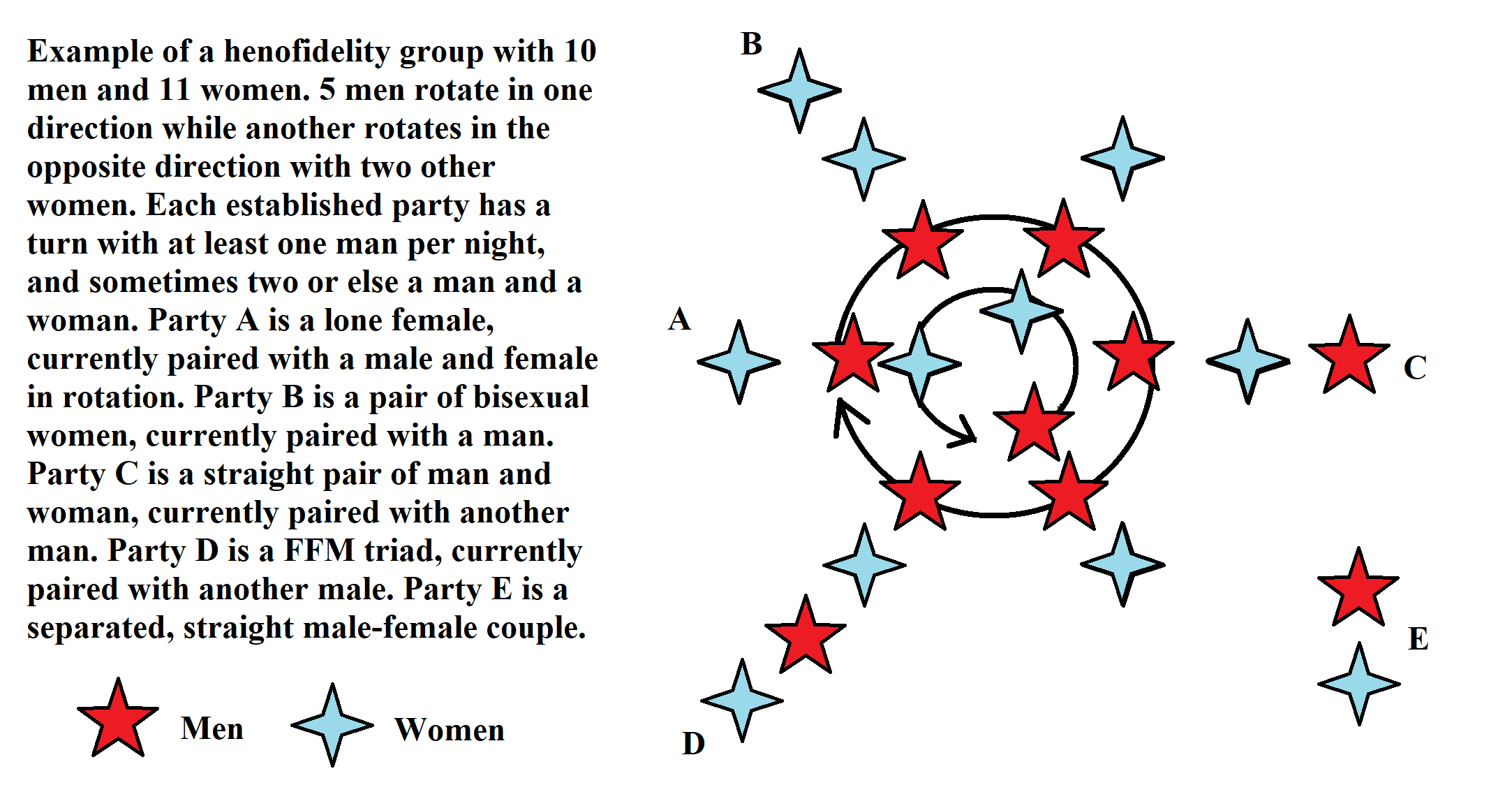Kerista was a utopian community or macrofamilial experiment that was spearheaded by John Presmont. Presmont claimed to have experienced an auditory hallucination telling him to create the community, though otherwise attributes his motives to simply having always desired to have sex with a larger number of beautiful women and his design toward this end.[1]
Keristans practiced what would come to be known as polyfidelity, or “group marriage.” As with any marriage, fidelity implied exclusivity and loyalty to the “family,” but the family was composed of Presmont and the younger men and women he convinced to take part in his familial experiment. As Presmont saw things, it truly was meant to be a familial experience, with family bonding and a wholesome, jealousy-free atmosphere. Jealousy was to be hampered by a rotating schedule that paired couples of the opposite sex for each night without any preferentiality. The larger group was broken up into various “BFICs” or best friend groups, wherein the scheduling took place. However, participants who wanted to have sex between scheduled nights spent together could do so anytime they wanted to, though it had to take place behind closed doors and with due discretion so as not to incite jealousy. Displays of open sexual affection were discouraged. No sexual activity was allowed outside the bounds of the group marriage.
The community structure was inspired by the Jewish Kibbutz, being an income-sharing commune. Members suggest that they lived upper class lifestyles on a middle class income due to their communal living, and that they were soon making, altogether, millions of dollars from a computer company they started together. All money earned from within or outside of the community was shared to the community at-large. Keristans, however, had access to a few hundred dollars for pocket money at basically all times. If they wanted to make a large purchase, they had to persuade the community that it would be a good idea.
The participants seem to have overall learned a great deal and experienced a lot from their time spent in Kerista. As tends to be the case, they blame the founder for the problems they experienced, citing his overbearing influence. But when listening to Presmont, it seems that this is unlikely to be the full story, as he seems to genuinely express a desire to have a leaderless arrangement, though while recognizing his role as the founder and his necessary input as the architect of the community infrastructure. What generally tends to happen in communistic groups such as this is that the founding member will both have genuinely good intentions and Coyote-like tendencies, meaning that their good intentions will be met with the developmental shortcomings and jealousy of the non-founding members, which in turn tend to justify some degree of advantage-taking on behalf of the otherwise well-meaning founder. At Kerista, this seems to have been the case as well. The members eventually cornered Presmont, who in return decided to leave the community, after which it soon fell apart. While Presmont seems to have been a particularly influential member, described as an “alpha male” who always got the most beautiful women, he also seems to have been at least somewhat genuine in his desire to establish a fair playing field, and the loss of his presence led to the end of the experiment, suggesting that the others were not up to the task. Past members express that polyfidelity is indeed a working model that may still be right for some people, but that many of them have settled with monogamy either due to the power of pair-bonding or because polyfidelity is not normalized to the point that it can be maintained without a significant degree of energy. The wider society, so it seems, applies pressures toward serial monogamy instead.
One of the major design flaws that I see in the Kerista experiment is social constructionism or constructivism and psychological idealism. For instance, while also showing some modernist qualities, such as desiring to be rational and avoid romance, the Keristans tried to outlaw certain emotions, particularly jealousy, making a rule that one does not feel jealousy, as if a statute has any influence in the matter of one’s feelings. Presmont seems to have been greatly influenced by Gestalt psychology, the main meetings of the family being called Gestalt-O-Ramas. This no-doubt led to some feelings of inward oppression on behalf of participants, likely relatable to that experienced by a student of Buddhism. Another design flaw seems to be resistance to pair-bonding. It seems that some of the members, even while in regular rotation, formed pair-bonding tendencies that came into conflict with the groups larger mission. All-in-all, its flaws can be narrowed down to irrational, Counter-Enlightenment elements.
It seems that, even with its flaws, though, polyfidelity was a worthwhile experiment. At some points, family members apparently numbered in the 30s, and the experiment lasted for over 30 years, beginning with some houses and storefronts before growing into the commune. Those who participated generally seem to see the commune as a somewhat positive experience even if they blame Presmont for his dominance. This was, afterall, a commune, and with that came all of the centralization that is typical, and so had design flaws to begin with.
It seems time that a new model of sexual liberation be explored, taking insights from both monogamy and polyfidelity. What is great about both monogamy and polyfidelity is that there is some wholesomeness involved in the exclusivity and impartial loyalty that is established. Monogamy has the advantage of pair-bonding, which can be important, especially among individuals who may be independently desirable to their matches beyond the desirability of the group at-large. That is, some pairs may decide that their bond is more important to them than the ability to have sex with other people. Nonetheless, even among officially monogamous pairs, things often fall apart, leading to serial rather than permanent monogamy, and even when this is not the case monogamous individuals are often found to be cheating in some way. Polyamory and polyfidelity have the advantage of allowing people to do whatever they want to.
I call my new model henofidelity. Henofidelity is different from polyfidelity in that it does not treat polyfidelity as an end in itself, but instead as a starting place from which pair-bonds may or may not be established. If a pair-bond is established, the pair can either “tap out” of the sleeping rotation or take part in the rotation as a pair or even a polyfidelity unto itself. Upon entering and going through the celibacy and trial period, male and female members are paired up within BFICs according to the schedule and have sex with one another for those nights. Pair-bonding is not necessary encouraged or discouraged, but, if it occurs, the couple can decide to separate themselves sexually from the rest of the BFIC or continue to be involved in the rotation.

If the couple wishes to continue in rotation, they must first find a replacement for the sex of the member they will be accepting into their bedroom. For instance, if the couple will be pair-bonding and accepting female visitors, this will ruin the rotation and leave a male without a female for a night unless another female is found to take her place. Similarly, if the couple desires to have a man in the rotation for the night, they will need to find a replacement for him. Couples can turn into triads by adopting a third, and can established polyfidelities within the polyfidelity if they desire to do so, but they must replenish what has been taken.
Henofidelities can ultimately organize their BFICs toward sexual tastes and fantasies, such that men and women who are not interested in group sex do not have to be in rotation with couples, triads, and etc. but can nonetheless be in rotation with other singles. BFICs can further be broken up between those who enjoy group sex for different reasons, such as between couples with a bisexual male and those with straight men or their partners who might enjoy activities to which a bisexual man would not be invited. It is important that matches are appropriately made so that quarrels do not arise. However, there should be some fair degree of permeability between BFICs, such that people can come and go between them within the larger henofidelity. Nonetheless, every henofidelity can draw its limits where it wants to, and can be as liberal or conservative as it pleases. Its contractual obligations can limit sexual behaviors, including certain activities such as anal and oral sex, or between certain individuals such as those of the same sex. It is completely up to the BFICs and the henofidelity overall what is allowed in the cellular family. The rules can be as arbitrary as agreements allow for.

Even if henofidelity is not something that individuals end up doing as a life-long thing, it seems to be a potentially strong starting-place for young adults to begin living out their sexual lives during their prime, even if while hoping to establish a pair bond. Henofidelity would basically eliminate the phenomenon known as incels, or “involuntary celibates,” and the loneliness experienced by young men and women alike, both of whom would benefit from enjoyable and intimate sexual interaction with one another within a wholesome framework of fidelity. Nothing would stop them from establishing monogamous pair bonds and even marriages in the future.
Rather than the communist model of economy, it seems that a mixed economy would be most appropriate for a group marriage. Indeed, communistic elements are appropriate within a family, but not all families need be income-sharing agreements. Indeed, many monogamous arrangements are not income-sharing arrangements, as established in a prenuptial agreement. The same could be true for a henofidelity group, which may desire to maintain communistic elements within limits, allowing for personal accumulation while ensuring the wellbeing of the family overall. Family members could be “taxed” on their income, for instance, while nonetheless being allowed to derive an income of their choosing and otherwise under their control. If desired, this could come in the form of paying a “room value tax,” and could be modeled on Georgist or Pigovian lines rather than on income itself. It would be up to each BFIC how they are to be arranged, a la geo-mutualist panarchism.
[1] The Counter-Enlightenment themes are already pouring out, but there does seem to be a semi-rational thread to this as well

